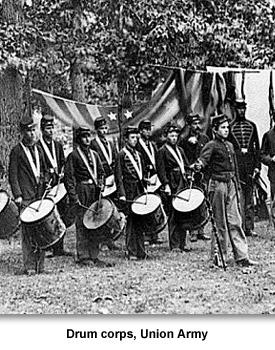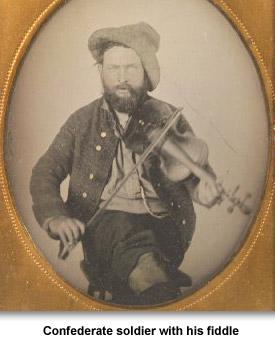Music and Arts
Tennesseans continued to enjoy and create music and fine arts during the Civil War. Many of these creative pieces, of course, were about the war.
The United States government even hired artists to travel with armies and paint battle scenes, several of which occurred in Tennessee.
Music
Singing and playing music was a popular pastime in Tennessee during the Civil War. Each side had its favorite songs–“Dixie’s Land” for Confederate supporters and “Yankee Doodle” for Union.
Stories were written about Southern women holding their noses and humming or singing “Dixie’s Land” when passing Union soldiers.
Another popular song for soldiers was “Goober Peas.” Goober peas is another name for peanuts. The song lyrics are written for fun. Since it is such a good marching song, it is listed today on the Boy Scouts of America website for scouts to sing.
Listen to a version of "Goober Peas."
One of the most inspirational songs from the Civil War times that is still played and sung today is the "Battle Hymn of the Republic.” The tune was a Methodist camp meeting song in South Carolina, and was sung in churches belonging to free blacks. New lyrics about John Brown’s body were added after Brown’s raid on Harper’s Ferry in 1859.
“John Brown’s Body,” had become a popular marching song with Union troops when author and abolitionist Julia Ward Howe heard soldiers singing the song in 1861 as they prepared for battle. She didn’t like the words, and went home that night and wrote the words to the tune now known as the “Battle Hymn of the Republic.” Listen to "Battle Hymn of the Republic."
Other songs reinforced the dreadfulness or war, such as “Lucilla, the Maid of Shiloh,” which reads “O’er Shiloh’s bleak and dreary hills, ...She marks her pathway with the slain.” The lyrics of this song and others attest to the great suffering and resiliency of soldiers and their families. These songs show the changing views many Americans developed about the ongoing war. As the war progressed, many people became disheartened by the number of casualties and the amount of destruction the war caused.
For most people, they just wanted the war to end and their love ones to come home. Another popular song for both sides was “When Johnny Comes Marching Home.”
Listen to "When Johnny Comes Marching Home."
Picture Credits:
- Photograph of the Drum Corps, 93rd New York Infantry, U.S.A. Photographer, Timothy O’Sullivan. Library of Congress
- Tintype of a Confederate soldier. It is inscribed as “a Tennessee volunteer, wounded and who gallantly remarked, ‘If I can’t fight, I can still fiddle.’” Tennessee State Museum Collection, 9.643.1
Acknowledgments:
Music Credits
The music for "Battle Hymn of the Republic," "When Johnny Comes Marching Home Again," and "Goober Peas" was provided by the Mishaw Family Singers, recorded in 2008. Produced by Dan Justice with Mary Unobsky and Graham Perry.
Civil War and Reconstruction >> Civil War >> Life At Home >> Music and Arts


 Sponsored by: National Endowment for the Humanities
Sponsored by: National Endowment for the Humanities